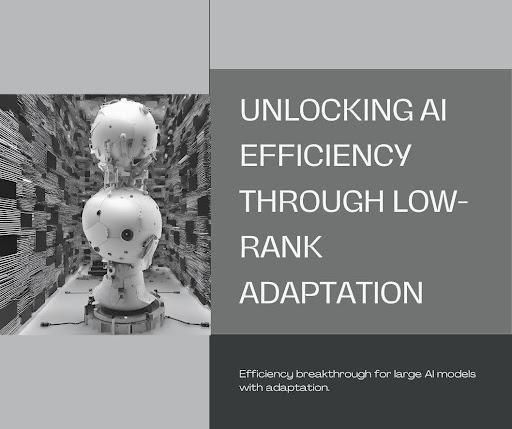In the ever-evolving field of artificial intelligence (AI), the relentless pursuit of more powerful models has led to the creation of behemoths like GPT-3, boasting over 175 billion parameters. While these models have demonstrated unprecedented capabilities, their immense size poses significant challenges for fine-tuning and practical deployment. Enter Low-Rank Adaptation (LoRA), a novel approach poised to revolutionize the way we optimize and deploy large-scale AI models.
The Challenge of Fine-Tuning Massive Models
Foundation models like GPT-3 have shown remarkable proficiency in natural language tasks due to their extensive pretraining on vast datasets. However, adapting these models to specific domains remains a critical requirement for real-world applications. Conventional fine-tuning methods involve updating a substantial number of parameters, which not only demands exorbitant computational resources but also poses environmental concerns due to high energy consumption. The need for a more efficient method has never been more urgent.
Unveiling Low-Rank Adaptation
Low-Rank Adaptation (LoRA) addresses these challenges by decomposing the weight update matrices into smaller, more manageable components. Instead of adjusting the entire model, LoRA focuses on updating only two smaller matrices, thereby reducing the number of learned parameters by over 99%. This innovative approach results in significant computational and memory efficiency, enabling faster iterations and deployments with minimal loss in task accuracy.
The Mechanics of LoRA
Low-Rank Adaptation (LoRA) optimizes the fine-tuning of large-scale models by employing low-rank decomposition. Instead of updating entire weight matrices, LoRA decomposes them into two smaller matrices, WXW_XWX and WYW_YWY, significantly reducing the number of parameters to be adjusted. The original weight matrix remains unchanged, and only the smaller matrices are updated, leading to substantial computational and memory savings.
This approach maintains model accuracy while achieving over 99% reduction in trainable parameters, drastically shortening training times. LoRA’s efficiency allows for rapid and cost-effective fine-tuning of massive models like GPT-3, democratizing access to advanced AI capabilities.
Empirical Evidence and Benefits
The study provides comprehensive empirical evidence supporting the efficacy of LoRA. Tests conducted on models with up to 175 billion parameters demonstrate that LoRA achieves order-of-magnitude speedups and memory savings. For example, fine-tuning GPT-3 using traditional methods would require an estimated 10 million GPU hours, equivalent to several months of continuous optimization. In contrast, LoRA can reduce this time by up to 76%, making it feasible to accomplish in mere weeks.
The study also highlights the impressive memory savings achieved through LoRA. For instance, tuning a mid-size model like GPT-2 sees a reduction in memory usage from 150GB to 85GB, translating to a 32% decrease. These efficiency gains are crucial for democratizing access to advanced AI capabilities, allowing smaller research labs and enterprises to leverage state-of-the-art models without prohibitive costs.
Real-World Applications and Future Directions
LoRA’s potential extends beyond theoretical advancements, offering tangible benefits in real-world applications. By reducing the computational resources required for fine-tuning, LoRA enables more frequent and adaptive updates to models, aligning them with the latest data and trends. This capability is particularly valuable in dynamic fields such as healthcare, finance, and climate science, where timely and accurate predictions can have significant societal impacts.
Moreover, LoRA’s efficiency fosters interdisciplinary collaboration, enhancing fields like medical imaging by improving diagnostic accuracy and speed. In natural language processing, it enables specialized models for tasks such as legal or scientific summarization, boosting productivity and decision-making.
To conclude, LoRA marks a significant shift in fine-tuning massive AI models by minimizing the number of parameters that need updating. This approach enhances efficiency and accessibility, making model optimization more sustainable. As specialized AI models become increasingly important, LoRA’s innovation provides a balance of performance and resource management. Saloni Thakkar’s work on LoRA addresses computational challenges and supports the wider adoption of advanced AI technologies, marking a new era in efficiency.







